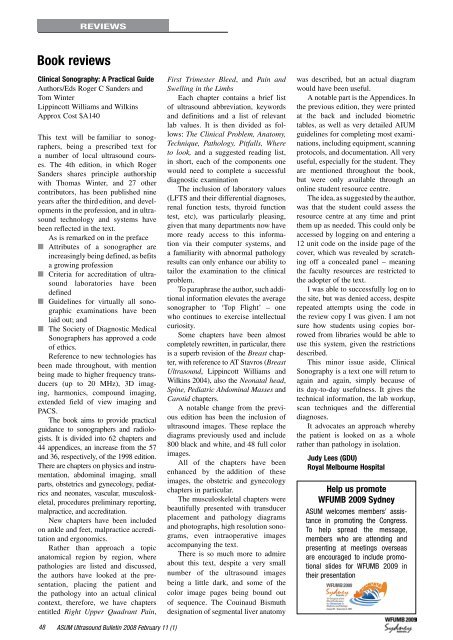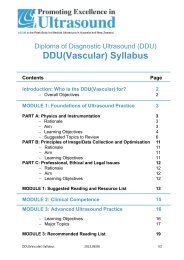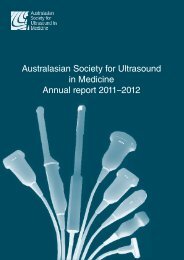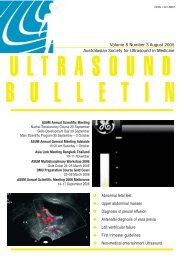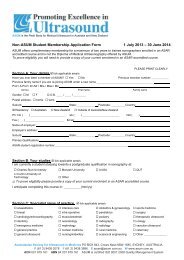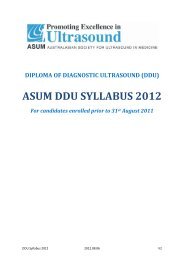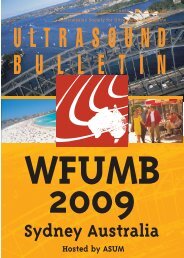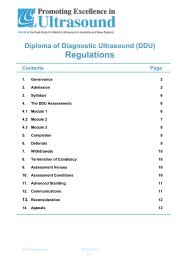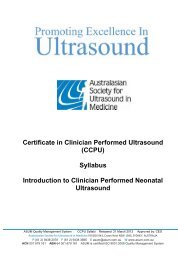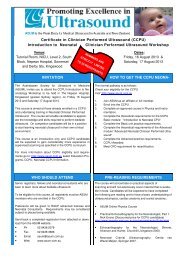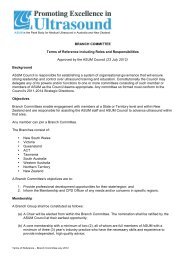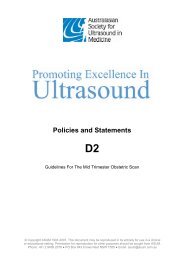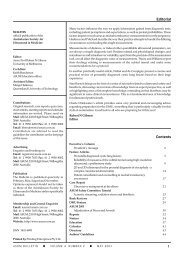Volume 11 Issue 1 (February) - Australasian Society for Ultrasound ...
Volume 11 Issue 1 (February) - Australasian Society for Ultrasound ...
Volume 11 Issue 1 (February) - Australasian Society for Ultrasound ...
Create successful ePaper yourself
Turn your PDF publications into a flip-book with our unique Google optimized e-Paper software.
REVIEWS<br />
Book reviews<br />
Clinical Sonography: A Practical Guide<br />
Authors/Eds Roger C Sanders and<br />
Tom Winter<br />
Lippincott Williams and Wilkins<br />
Approx Cost $A140<br />
This text will be familiar to sonographers,<br />
being a prescribed text <strong>for</strong><br />
a number of local ultrasound courses.<br />
The 4th edition, in which Roger<br />
Sanders shares principle authorship<br />
with Thomas Winter, and 27 other<br />
contributors, has been published nine<br />
years after the third edition, and developments<br />
in the profession, and in ultrasound<br />
technology and systems have<br />
been reflected in the text.<br />
As is remarked on in the preface<br />
n Attributes of a sonographer are<br />
increasingly being defined, as befits<br />
a growing profession<br />
n Criteria <strong>for</strong> accreditation of ultrasound<br />
laboratories have been<br />
defined<br />
n Guidelines <strong>for</strong> virtually all sonographic<br />
examinations have been<br />
laid out; and<br />
n The <strong>Society</strong> of Diagnostic Medical<br />
Sonographers has approved a code<br />
of ethics.<br />
Reference to new technologies has<br />
been made throughout, with mention<br />
being made to higher frequency transducers<br />
(up to 20 MHz), 3D imaging,<br />
harmonics, compound imaging,<br />
extended field of view imaging and<br />
PACS.<br />
The book aims to provide practical<br />
guidance to sonographers and radiologists.<br />
It is divided into 62 chapters and<br />
44 appendices, an increase from the 57<br />
and 36, respectively, of the 1998 edition.<br />
There are chapters on physics and instrumentation,<br />
abdominal imaging, small<br />
parts, obstetrics and gynecology, pediatrics<br />
and neonates, vascular, musculoskeletal,<br />
procedures preliminary reporting,<br />
malpractice, and accreditation.<br />
New chapters have been included<br />
on ankle and feet, malpractice accreditation<br />
and ergonomics.<br />
Rather than approach a topic<br />
anatomical region by region, where<br />
pathologies are listed and discussed,<br />
the authors have looked at the presentation,<br />
placing the patient and<br />
the pathology into an actual clinical<br />
context, there<strong>for</strong>e, we have chapters<br />
entitled Right Upper Quadrant Pain,<br />
First Trimester Bleed, and Pain and<br />
Swelling in the Limbs<br />
Each chapter contains a brief list<br />
of ultrasound abbreviation, keywords<br />
and definitions and a list of relevant<br />
lab values. It is then divided as follows:<br />
The Clinical Problem, Anatomy,<br />
Technique, Pathology, Pitfalls, Where<br />
to look, and a suggested reading list,<br />
in short, each of the components one<br />
would need to complete a successful<br />
diagnostic examination<br />
The inclusion of laboratory values<br />
(LFTS and their differential diagnoses,<br />
renal function tests, thyroid function<br />
test, etc), was particularly pleasing,<br />
given that many departments now have<br />
more ready access to this in<strong>for</strong>mation<br />
via their computer systems, and<br />
a familiarity with abnormal pathology<br />
results can only enhance our ability to<br />
tailor the examination to the clinical<br />
problem.<br />
To paraphrase the author, such additional<br />
in<strong>for</strong>mation elevates the average<br />
sonographer to ‘Top Flight’ – one<br />
who continues to exercise intellectual<br />
curiosity.<br />
Some chapters have been almost<br />
completely rewritten, in particular, there<br />
is a superb revision of the Breast chapter,<br />
with reference to AT Stavros (Breast<br />
<strong>Ultrasound</strong>, Lippincott Williams and<br />
Wilkins 2004), also the Neonatal head,<br />
Spine, Pediatric Abdominal Masses and<br />
Carotid chapters.<br />
A notable change from the previous<br />
edition has been the inclusion of<br />
ultrasound images. These replace the<br />
diagrams previously used and include<br />
800 black and white, and 48 full color<br />
images.<br />
All of the chapters have been<br />
enhanced by the addition of these<br />
images, the obstetric and gynecology<br />
chapters in particular.<br />
The musculoskeletal chapters were<br />
beautifully presented with transducer<br />
placement and pathology diagrams<br />
and photographs, high resolution sonograms,<br />
even intraoperative images<br />
accompanying the text.<br />
There is so much more to admire<br />
about this text, despite a very small<br />
number of the ultrasound images<br />
being a little dark, and some of the<br />
color image pages being bound out<br />
of sequence. The Couinaud Bismuth<br />
designation of segmental liver anatomy<br />
was described, but an actual diagram<br />
would have been useful.<br />
A notable part is the Appendices. In<br />
the previous edition, they were printed<br />
at the back and included biometric<br />
tables, as well as very detailed AIUM<br />
guidelines <strong>for</strong> completing most examinations,<br />
including equipment, scanning<br />
protocols, and documentation. All very<br />
useful, especially <strong>for</strong> the student. They<br />
are mentioned throughout the book,<br />
but were only available through an<br />
online student resource centre.<br />
The idea, as suggested by the author,<br />
was that the student could assess the<br />
resource centre at any time and print<br />
them up as needed. This could only be<br />
accessed by logging on and entering a<br />
12 unit code on the inside page of the<br />
cover, which was revealed by scratching<br />
off a concealed panel – meaning<br />
the faculty resources are restricted to<br />
the adopter of the text.<br />
I was able to successfully log on to<br />
the site, but was denied access, despite<br />
repeated attempts using the code in<br />
the review copy I was given. I am not<br />
sure how students using copies borrowed<br />
from libraries would be able to<br />
use this system, given the restrictions<br />
described.<br />
This minor issue aside, Clinical<br />
Sonography is a text one will return to<br />
again and again, simply because of<br />
its day-to-day usefulness. It gives the<br />
technical in<strong>for</strong>mation, the lab workup,<br />
scan techniques and the differential<br />
diagnoses.<br />
It advocates an approach whereby<br />
the patient is looked on as a whole<br />
rather than pathology in isolation.<br />
Judy Lees (GDU)<br />
Royal Melbourne Hospital<br />
Help us promote<br />
WFUMB 2009 Sydney<br />
ASUM welcomes members’ assistance<br />
in promoting the Congress.<br />
To help spread the message,<br />
members who are attending and<br />
presenting at meetings overseas<br />
are encouraged to include promotional<br />
slides <strong>for</strong> WFUMB 2009 in<br />
their presentation<br />
48 ASUM <strong>Ultrasound</strong> Bulletin 2008 <strong>February</strong> <strong>11</strong> (1)


